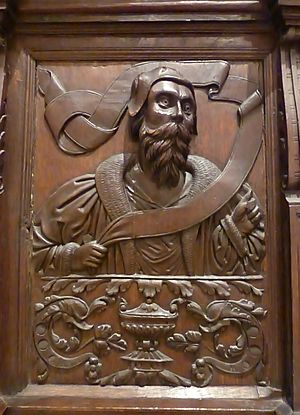Laird facts for kids
A laird (pronounced "lair-d") is the owner of a large, long-established piece of land in Scotland. In the old Scottish system, a laird was ranked below a baron but above a gentleman. This special rank was given to lairds whose land ownership was officially recognized by the Lord Lyon King of Arms, who is Scotland's expert on titles and heraldry.
Lairds are often called by their name followed by "of" and then the name of their land, like "John Smith of Glenbogle." However, "laird" is a courtesy title, which means it's a polite way to address someone, but it doesn't have a formal legal status like a noble title.
In the past, a "bonnet laird" was a term for smaller landowners in the countryside. They were called this because they wore a simple bonnet like regular farmers, not fancy hats. Bonnet lairds were above farmers but below the more important lairds.
Today, you might see websites selling tiny pieces of Scottish land, claiming you can become a "laird" by buying one. But the Lord Lyon has said these claims are not real or meaningful.
Contents
What Does 'Laird' Mean?
The word "laird" comes from the Scots word that is similar to the English word "lord." Both words come from a very old English word, "hlafweard," which meant "warden of loaves" – someone who looked after the food.
The word "laird" has been used in writing since the 1200s. Over time, "laird" and "lord" started to mean different things. "Lord" became linked to noble titles, while "laird" stayed connected to owning land, especially in Scotland.
Lairds Through History
In the 1400s and 1500s, the title "laird" was used for landowners who held their land directly from the King or Queen. These lairds were important enough to attend the Scottish Parliament. They often ruled their estates like small princes, with their castles acting as local centers of power.
Originally, in the 1500s and 1600s, the term was also used for the main chief of a highland clan. This meant the land wasn't just personal property; it came with duties to the community living on it.
Lairds had certain local rights related to their land. In the old Scottish Parliament, lairds had voting rights, even though they voted through representatives called "Commissioners of the Shires." To be a laird, you needed to own a certain amount of land. A woman who owned a lairdship in her own right was often called "Lady."
Even though "laird" sounds like "lord" and historically meant something similar, it is not a title of nobility. It's more like the English term "lord of the manor" or "squire" – it means you own land, but it doesn't give you a seat in the House of Lords (the upper house of the UK Parliament).
A laird who has a coat of arms officially registered in Scotland is considered part of Scotland's minor nobility. The Lord Lyon King of Arms is the person who decides if someone can officially use a "territorial designation" (like "of Glenbogle") as part of their name, recognizing them as a laird.
Lairds Today
A study in 2003 looked at modern Scottish Highland estates. It found that these large estates are often owned by people who don't live there all the time. They use the land, which can be 15,000 to 20,000 acres, for hunting and family holidays. Most lairds (82%) are men.
Sometimes, in popular culture, you might hear of lairds. For example, in the TV show Monarch of the Glen, the wife of the laird is called "Lady of Glenbogle." Even King George V and Queen Mary were sometimes called "The Laird and Lady of Balmoral" by the Scottish newspapers in the 1920s and 1930s.
Souvenir Plots and False Titles
In recent times, a new idea about lairdship titles has appeared. Some websites and online sellers offer tiny "souvenir plots" of Scottish land, often just one square foot in size. They claim that buying one of these plots makes you a "laird."
However, the Court of the Lord Lyon, which is Scotland's official authority on titles, says these claims are not real. This is because you can't have many "lairds" of the same piece of land at the same time. Also, Scottish law (the Land Registration (Scotland) Act 2012) says that these tiny "souvenir plots" are too small to be useful and cannot be officially registered as owned land.
Since you don't legally own the land, you can't claim a title like "laird" that is based on owning land. The Lord Lyon has clearly stated:
- The term "laird" is a description for the owner of a large estate, not a formal title.
- It is not suitable for someone who owns a regular house or a tiny souvenir plot.
- Owning a souvenir plot is not enough to get a coat of arms from the Lord Lyon.
So, while it might sound fun to be a "laird" by buying a tiny plot of land, it doesn't give you any real legal title or status in Scotland.
See also
- Forms of address in the United Kingdom
- Laird (surname)
- Scottish feudal barony



